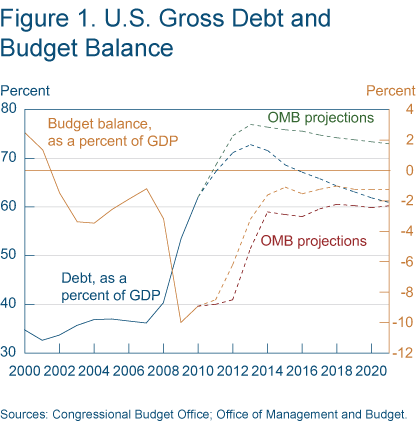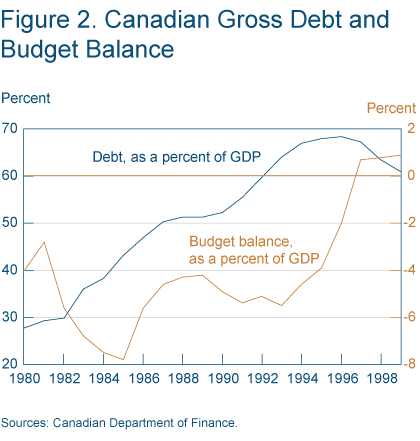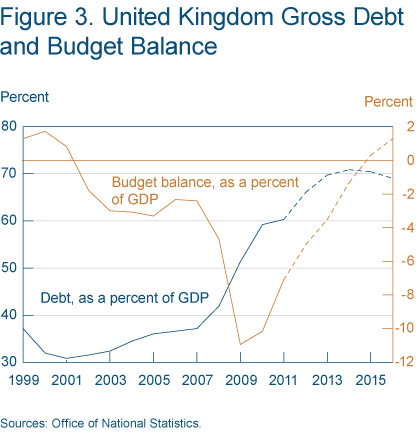- Share
Reducing the Federal Deficit: Approaches in Some Other Countries
The United States is not the first advanced modern economy to face a serious federal budget challenge. A number of countries have seen their debt rise to unacceptable levels in recent decades, and they have taken steps to rein it in. We explore the approaches that Canada and the United Kingdom have used. Though there are important differences in approaches and countries, we draw five useful lessons for the reforms that may be proposed in the U.S. as it addresses its fiscal challenges.
The views authors express in Economic Commentary are theirs and not necessarily those of the Federal Reserve Bank of Cleveland or the Board of Governors of the Federal Reserve System. The series editor is Tasia Hane. This paper and its data are subject to revision; please visit clevelandfed.org for updates.
As highlighted in current public discussions, the United States faces a federal budget challenge over the long term. The financial crisis produced large deficits due both to the rescue of the financial industry and to decreases in taxes and increases in social welfare benefits, which are standard in recessions. These deficits caused the federal debt held by the public to increase by 79 percent from 2007 to 2010.
Projections of the path for the debt show it continuing to rise over the next decade. When the Congressional Budget Office takes into account historical tax and spending behavior, the debt skyrockets to unsustainable levels within 25 years (figure 1).

It is now widely recognized that the United States will have to find some combination of revenue increases and government spending reductions in order to bring projected debt under control. (In August 2011, Standard and Poor’s downgraded the U.S. long-term credit rating from AAA to AA+, citing the need for a credible plan to rein in projections.) During his first post-FOMC press conference, Federal Reserve Chairman Ben Bernanke expressed his concern over future budget shortfalls, calling them “the most important economic problem ... in the longer-term that the United States faces.”
The United States is not alone in facing large fiscal imbalances and a need for large corrections. The economic crisis wreaked havoc on the finances of governments worldwide. Several countries such as Greece, Portugal, and Ireland have sought help from the European Union (EU) after rating agencies downgraded assessments of their debt, leading to higher borrowing costs. Many countries in the European Union, responding to a stipulation in the Maastricht treaty that members have deficits no greater than 3 percent of GDP, passed austerity measures to rein in their budgets. The United Kingdom, noting the downgrades in the public debt ratings of some EU countries, has taken aggressive steps to reduce its deficit to 1 percent of GDP by 2015.
In order to inform some of the choices the United States faces, this Commentary examines the structures of the austerity measures that some other nations have adopted. Specifically, this article focuses on the experience of two developed countries: Canada in 1995 and the United Kingdom (UK) in 2011. The outcomes (or projected outcomes in the case of the UK) are discussed, and potential guidelines for a U.S. budget reform based on applicable plans from other nations are laid out.
Canada, 1995
Canada’s austerity program began in 1995, on the heels of a three-year recession. Despite the recession, the government had been returning a primary surplus (that is, revenues exceeded expenditures excluding interest on accumulated debt) for the six previous years; however, these surpluses were not sufficient to offset debt service payments, and so the debt continued to mount. After more than a decade of running deficits greater than 4 percent of GDP, Canada’s debt had climbed from below 30 percent of GDP in 1980 to 67 percent (figure 2).

In response, Canada embarked upon a widespread fiscal consolidation. Although the reform contained some tax increases, income taxes were not changed. Instead, increased revenue was secured with very modest changes to business taxes and higher taxes on tobacco and gasoline. Making up only $1 for every $7 of government spending reduction, changes to tax revenue collection composed a very small portion of the total reform package. The lion’s share of the consolidation came from cutting expenditures.
The cuts were broad and deep, averaging roughly 23 percent over three years, with some departments facing cuts of over 50 percent to their budgets. Large savings, particularly in transportation and resource management, came from consolidating department roles and from either privatizing some federal operations or transferring them to provincial government.
In line with a greater decentralization of government administration, the federal government converted many cost-sharing programs into block grants, forcing localized governments to also make difficult choices about how much public service to provide. Federal cash transfers to provinces had exceeded 4 percent of GDP for over 20 years; from 1995 to 1999 they averaged 3.3 percent.
Over the same period, provincial expenditures on programs declined by 11.8 percent. Federal, provincial, and local government employment fell by roughly 15 percent, 9 percent, and 6.5 percent, respectively, from 1995 to 1999. Overall, total government spending as a fraction of GDP declined from 48.5 percent in 1995 to 42.7 percent in 1999.
The late-1990s were a time of strong economic conditions in Canada, with steady output growth and a near 3 percentage point decline in the unemployment rate. Within only three years, Canada began producing surpluses and continued to do so for the next 10 years. Canadian economist Stephen Gordon has reported that the recovery period was largely due to the concurrent growth of Canada’s largest trading partner, the United States, which boosted Canadian exports. At this time, the marginal impact of Canada’s fiscal reform on its subsequent GDP growth and unemployment reductions is unclear. Nevertheless, although Canada’s economic prosperity during this period cannot be directly attributed to its fiscal reforms, Canada’s fiscal consolidation did translate that growth into massive reductions in deficits and eventually public debt. By 2007, the debt-to-GDP ratio was below 30 percent. By making hard choices about the size of federal government, Canada was well-positioned to take full advantage of the years of economic growth to restore its fiscal house.
United Kingdom, 2011
The financial crisis that began in 2008 put the fiscal situation in the United Kingdom into public view. Primary deficits had been run since early in the decade (2003) but had only recently topped 4 percent of GDP in any one year. Since the onset of the crisis, the annual deficit has averaged 9.3 percent of GDP. Meanwhile, the level of debt as a percentage of GDP has risen from 31.5 percent at the end of 2002 to over 60 percent in 2010 (figure 3).

Anticipating that without reform its debt-to-GDP ratio would continue to rise over the next five years, the United Kingdom developed a plan to rebalance its fiscal situation and encourage growth. As in Canada, the UK structured the bulk of the response on spending reductions.
According to Her Majesty’s Treasury’s 2011 budget, corporate tax decreases, drops in some land tax rates, and an increase in the personal tax allowance are expected to help boost GDP back up to a 2.9 percent growth rate by 2013. These changes would be more than offset by reforms to the personal tax system, as well as increases in the VAT (value added tax), environmental taxes, and the supervision of tax avoidance. At a ratio of $3 in government spending reduction to each dollar of tax revenue increase, however, the tax changes compose a minority of the total reform package.
By far, the largest spending reductions come as a result of a new indexation process for public pensions, public benefits, and tax credits. This change will index these public expenditures to the Consumer Price Index (CPI) and is expected make up over a third of the £75 billion announced savings. Previously, these items were tied to the Retail Price Index (RPI), which has tended to increase more quickly than the CPI.
The CPI differs from the RPI in several respects. The RPI’s basket of goods and services is constructed differently than the CPI’s basket. Not only do the two baskets contain different items (most notably, unlike the CPI, the RPI contains mortgage interest payments and house purchase costs), but also the weights assigned to items in the basket are calculated differently. Furthermore, the RPI uses an arithmetic mean to average price changes within the basket while the CPI uses a geometric mean. This causes the CPI to respond more to a downward movement in the price of an item than to an equivalent upward movement in the price of the same item. Put another way, even if the CPI and RPI baskets were constructed with exactly the same method, the CPI would never be greater than the RPI because of the averages used.
The UK plan also trims deficits by reducing tax credits (thereby increasing tax revenue), shrinking local capital expenditures, and loosening carbon reduction commitments. The government’s share of contributions to the national safety net will be reduced by increasing both employee and employer contributions over the next five years. Despite these changes, current expenditures are still expected to rise over the medium term to meet obligations for social security benefits and debt interest payments, as well as to increase investment in education and infrastructure.
Projections estimate that the debt-to-GDP ratio will continue to rise into fiscal year 2014, peaking at 70.9 percent. By 2015, it is expected that a current surplus of 0.4 percent of GDP will be achieved, which will allow the debt-to-GDP ratio to fall back to 69.1 percent by the end of 2015. The marginal impact of fiscal consolidation is to reduce net public debt by 4 percent of GDP within four years.
Some of this recovery is expected to result from increased economic growth, as forecasts project that growth will return to a 3 percent trend by 2013. Under this scenario, growth is boosted by increases in business fixed investment and exports, two targets of expanded investment spending. Higher growth in turn improves overall economic conditions, including reducing unemployment from 8.2 percent down to 6.4 percent in 2015.
Implications for the United States
The United States shares some characteristics with both Canada and the United Kingdom. All three countries have solidly established democratic governments as well as well-developed, modern economies. As in Canada and the United Kingdom, debt has accumulated from a history of consistent deficits (1998-2001 notwithstanding), and the accumulation has been escalated because of an economic recession.
At the same time, the United States is unique in some regards. One difference working in the United States’ favor is the standing of the U.S. dollar as the leading exchange currency. The demand for U.S. dollars from abroad reduces exchange rate risk and helps keep the nation’s interest rates low. On the other hand, a difference that works against the United States is that it has yet to see the largest contributor to its long-term future deficits fully realized—the entry of the baby boom generation into entitlement programs. This sets the bar for restoring fiscal balance much higher. Not only must the U.S. find a way to take action on revenues and spending to address near-term imbalances, it must also find a way to address even larger future transfers.
The two cases discussed above offer some takeaways for the reforms that may be proposed in the U.S. as it addresses its fiscal challenges. First, it should be noted that there is no one-size-fits-all ratio of government spending reductions to tax increases. Canada, with the higher spending-to-tax ratio, decided that its tax code was mostly adequate and identified overspending at the federal and provincial levels as the primary cause of deterioration in its federal budget. In contrast, the UK recognized that very low income taxes and an ever-narrowing income tax base played a critical role in the rapid surge in its deficits. In both cases, spending reductions made up a significantly greater proportion of the overall deficit reduction plan, but the degree to which tax revenue played a role differed.
Second, substantial curtailment of government spending tends to involve cutbacks in public employment and compensation. Some combination of wage freezes, staff reductions, and benefit reduction was common to both reforms. The spending-focused Canadian plan, however, made much larger cuts to public employment compared to the more balanced UK plan, which only increased contributions to public insurance.
Third, reformers may be more hesitant today to increase taxes on business than in the past. In contrast to 1990s Canada, where the only tax reforms were increases to business taxes, the modern UK is very determined to not raise corporate tax rates and, in fact, prefers to offer some subsidies to encourage business growth by either cutting corporate taxes or increasing government spending to invest in business. The hope is to use slower government spending to allow the UK to grow back to fiscal health. These differing views between the modern UK and 1990s Canada may reflect the increase in global competition over the last two decades.
Fourth, reform may be focused on the short term. Both Canada’s and the UK’s programs aim to achieve their budget balance goals in three to five years. A short timetable forces a nation to rely heavily on the commitment of the current government and less on the faith that future governments will make the hardest cuts. In this regard, front-loading the reform so that the bulk of tax and spending changes comes early on may better ensure that the program is completed. It should be strongly cautioned, however, that such a strategy can be significantly contractionary. An ill-timed, front-loaded reform might be counterproductive if it derails recovery, as a recession invariably increases budget deficits.
Finally, taking reforms on as soon as possible permits countries to take full advantage of eventual recoveries. Expansions follow recessions. When an expansion arrives, a country should be ready to harness the increase in tax revenue to restore its fiscal position.
References and Suggested Reading
- “On the Lessons to Be Learned from the Elimination of the Canadian Federal Deficit in the 1990s,” Stephen Gordon, 2010. Worthwhile Canadian Initiative (Web Blog).
- “What Promotes Fiscal Consolidation: OECD Country Experiences,” Stephanie Guichard, Mike Kennedy, Eckhard Wurzel, and Christophe André, 2007. OECD, Economics Department Working Papers, no. 553.
- “Budget 2011.” Her Majesty’s Treasury. HC 836. March 2011.
Suggested Citation
Carroll, Daniel R., and John Lindner. 2011. “Reducing the Federal Deficit: Approaches in Some Other Countries.” Federal Reserve Bank of Cleveland, Economic Commentary 2011-22. https://doi.org/10.26509/frbc-ec-201122
This work by Federal Reserve Bank of Cleveland is licensed under Creative Commons Attribution-NonCommercial 4.0 International





